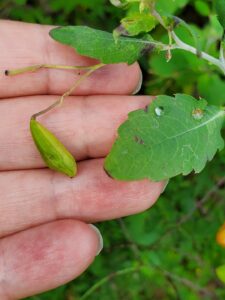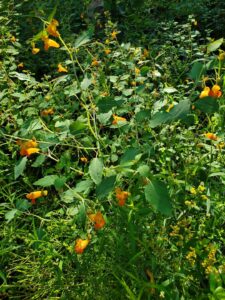August 28: Spotted Jewelweed: Explosions, Illusions, and Curatives

When ripe, the lightest touch will cause the spring loaded seed pods to roll back into tightly curled strips that forcibly eject and disperse 4-5 green seeds.
When this time of year rolls around, I look forward to walking my daughter to and from school each day. The slow walk along a quiet road gives us an easy peek at the goings on of the natural world that lies along its edges. The roadside includes a thick spruce-fir forest, a sandy sunny berm, and some watery trickles in ditches, allowing for a variety of plants to thrive. I have learned to allow a few extra minutes to get to school in September, as the walk passes hundreds of spotted jewelweed plants full of bursting seed pods. My daughter loves to tap the swollen green cases, creating an exciting explosion that leaves her with a handful of coiled pod and tiny seeds.
Spotted Jewelweed gets its name from the spotted golden-orange flowers and the shimmery jewel-like appearance of its wet leaves. It also has the common name “touch me not”, not because it is poisonous, but because of those exploding seed pods. The plant grows in patches two to five feet tall in wet areas, such as the ditches along our roadsides. The leaves are oval shaped and bluish-green, with a scallop-like appearance along their edges. The flowers have a pleasingly artistic shape, as one of the sepals is modified into a large, pouch-like structure with a long spur, which elegantly dangles from the plant.

The leaves have tiny hairs that are thought to help the plant retain water while keeping clear of dust and other particles.
The showy flower keeps its nectar at the bottom of the deep spur for long-tongued pollinators such as hummingbirds, bees, and butterflies. When these animals cross-pollinate the flowers, the plants produce the explosive elongated seed pods. When ripe, the lightest touch will cause the spring loaded sections of the five-chambered capsule to roll back into tightly curled strips that forcibly eject and disperse 4-5 green seeds. Jewelweed begins blooming in mid-summer and continues to do so until the plant is killed by frost, with the seed pods ripening near the end of their reign.

Spotted Jewelweed gets its name from the spotted golden-orange flowers and the shimmery jewel-like appearance of its wet leaves.
Not only does jewelweed have an exquisite flower and an entertaining system of seed dispersal, but its leaves and stems are fascinating too. If you submerge one of its leaves under water, it will miraculously transform into silver! This is just an illusion that occurs as the minute hairs on the leaves surface trap air and repel water. This trait is believed to help the plant retain water while keeping dust and other materials off of the leaves surface. Jewelweed stems are weak and watery, smooth and almost translucent, and range in color from pale to reddish green. The juice of the stems is medicinal, reliving itching and pain from a variety of trailside ailments including poison ivy and bug bites.
So next time your walking along a road or a BRLT preserve with some low lying wet areas, be sure to keep a look out for jewelweed with its exploding seed pods, magical leaves, and curative stems. You can even keep a few of the seeds and directly sow them in any partly shaded moist areas in your yard this fall. It makes a lovely addition to native plant gardens, and once established, it will maintain itself through annual seed production, leaving you with your own jewelweed patch to marvel at.





